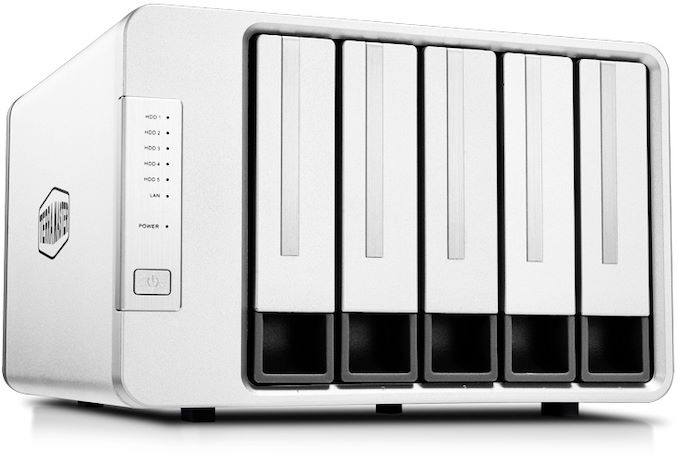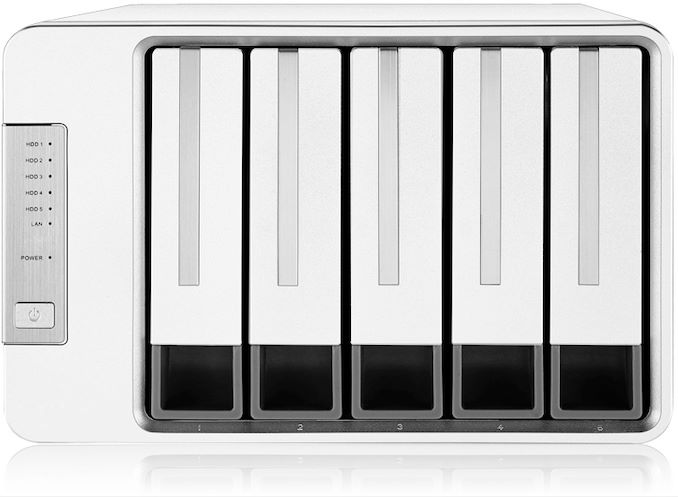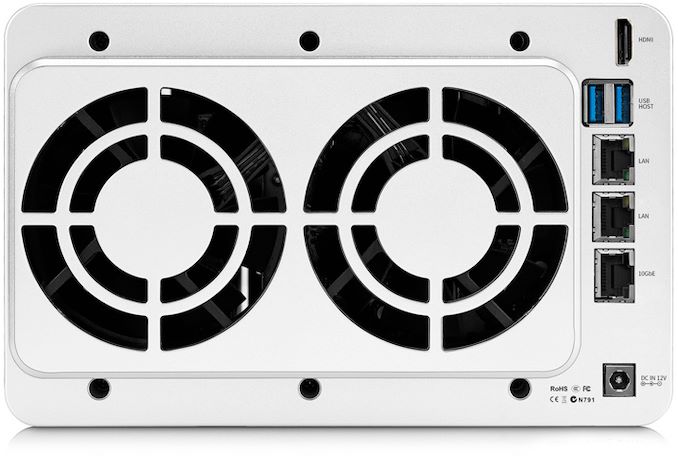CES 2020: TerraMaster Shows Off 5-Bay F5-422 NAS with 10 Gb Ethernet
by Anton Shilov on January 17, 2020 1:00 PM EST- Posted in
- NAS
- Storage
- Trade Shows
- TerraMaster
- CES 2020

TerraMaster unveiled a new five-bay NAS with a 10 GbE connectivity at this year's CES. The F5-422 is based upon Intel Apollo Lake SoC, and runs the company’s TOS 4.1 operating system on top of it, supporting up to 5 3.5-inch drives.
The TerraMaster F5-422 is powered by Intel’s Celeron J3455 quad-core SoC (1.5 GHz – 2.3 GHz) that is paired with 4 GB of memory (expandable to 12 GB). The unit can accommodate five 3.5-inch/2.5-inch hard drives or solid-state drives, which means with today's largest 16 TB HDDs, the NAS can accommodate a total of 80 TB in storage. And, as you'd expect for a modern NAS, the F5-422 supports various RAID modes, including RAID 1, RAID 5, RAID 6, and RAID 10.
Once released, the F5-422 NAS will be one of a handful of prosumer NASes on the market with support for high speed Ethernet, thanks to its one 10 GbE port. As well, the NAS supports two 1 GbE connectors, two USB 3.0 ports, and an HDMI display output. Though it should be noted that despite presence of an HDMI port, the NAS is not designed to work as a media player.
From performance point of view, the NAS is rated to read data at up to 670 MB/s speed as well as write data at up to 650 MB/s when all of its drives operate in RAID 5 mode. Meanwhile, TOS 4.1 OS supports SSD caching to accelerate I/O performance. The NAS can be used by large companies as it supports concurrent access for up to 500 users.
In addition to AES-NI and RAID modes, TerraMaster’s F5-422 with TOS 4.1 supports multiple security layers, including clustered Btrfs file system and snapshots as well as scheduled backups (including an option to back up to the cloud).
TerraMaster will begin selling the F5-422 shortly. Prices will vary with the configuration.
Related Reading:
- QNAP Unveils HS-453DX Silent NAS: Two HDDs, Quad-Core SoC, HDMI 2.0, 10 GbE
- QNAP Announces TS-332X Three-Bay NAS with 10 GbE
- QNAP Launches 16-Bay AMD Ryzen-Based TS-1677X NAS with 10 GbE
- Synology Introduces DiskStation DS1618+ with Intel Denverton
- Next-Gen NAS: An Interview with Alex Wang, CEO of Synology America
- QNAP Launches TS-963X NAS: x86 NAS With 9 Bays & 10 GbE/Multi-Gig Ethernet
Source: TerraMaster












33 Comments
View All Comments
Skeptical123 - Saturday, January 18, 2020 - link
Valantar you have your market scales backwards. The "DIY-capable enthusiasts" are the small market the small business nas market is relatively large. Also I don't see any features this nas is missing that a business would expect from a nas in the sub $1000 price range.As contrary to what you said nas are already at "commodity pricing levels " as you used the term. Remember the commodity Terramaster is selling is not at commodity hardware but a turn key data storage solution. Terramaster's pricing is in line with their competitors and online storage offerings from the tech giants. I'm sorry it's out of both of our budget but regardless that does not change reality.
Valantar - Sunday, January 19, 2020 - link
There's no such thing as a commodity priced NAS. Even bottom-rung two-bay units are hard to find below $200 without drives - meaning several times the price of usb storage - and most cheap ones use such terrible hardware that they are performance limited by their CPU or other hardware, not the (already slow) HDDs. Most of these barely fulfill the base requirement of "store stuff on your home network", which means their utility to entry level users is minimal. Good solutions with good app support, decent automatic backups and the like do exist, but are normally not cheap enough, so most users would much prefer a simpler and cheaper cloud storage option that does what they need in a very streamlined fashion, or just a USB drive. Some of the cheaper units are even enclosed without easily swapped drives, which is the dumbest idea ever for a data backup device, even for home use where the drives are parked the vast majority of the time. The price jumps for adding more bays in the same series are also rather ridiculous, as you often pay several hundred dollars for what amounts to a larger enclosure, bigger SATA backplane and slightly heftier power supply - none of which are even remotely expensive parts when mass produced.The problem is likely that commodity pricing requires high sales volumes for companies to stay afloat, which just doesn't happen with networked storage. And cloud storage is often free, otherwise cheap, and normally automatic with near zero configuration or even interaction, meaning that few home users even consider a NAS.
Also, I never said (or even implied) that the DIY-capable enthusiast market was in any way large, just that it's yet another potential market segment that is unlikely to buy an OTS NAS. Businesses are the only large NAS market, as they are the only market that has a direct need for both shared data storage and keeping data in-house, while also being used to expensive equipment purchases.
IMO most families could benefit quite a lot from a NAS, but it would then need to be relatively cheap, easily expandable (for longevity, nobody wants yet another recurring hardware purchase), as easy to use as cloud storage (including on your phone etc.) and easy to set up, while also being flexible enough in terms of configuration options to appeal to enthusiasts too. Without that you're limiting the product to a too small group of potential users for it to ever be successful.
close - Monday, January 20, 2020 - link
I think you just have too high expectations from this (maybe based on your personal needs) and project them onto the world. Reality is that even 2 bay units sell pretty well. This kind of commodity NAS addresses a far wider market than the self built ones do. They require less skill and time to configure and operate.Averant - Saturday, January 18, 2020 - link
While that's a fair point, Valantar, you have to remember that this is aimed as SOHO business owners. It's professional, rather than consumer(or prosumer, if you will) kit. It probably has the system support of an enterprise-level hardware, but I'm speculating at this point. For what it is, I'd say the price is fair in a business perspective.Valantar - Sunday, January 19, 2020 - link
If that's the case the price is indeed quite good - but the article frames it as a prosumer device. In which case it does seem to have pretty much everything one would want (except for that horribly anemic CPU), but it also pretty much limits its target audience to the "buys an iMac Pro for their hobby" demographic, i.e. a relatively small but wealthy group.jabber - Tuesday, January 21, 2020 - link
Indeed. I've swapped out huge Dell servers that cost a small firm of say 10 people $500 a month in fees for a QNAP 2 bay NAS in RAID1.All they actually needed was a place to file share from and do backups to. That's all a lot of small firms require. No $10000 server required.
ksec - Saturday, January 18, 2020 - link
Source? That is quite expensive coming from TerraMaster.Averant - Saturday, January 18, 2020 - link
It's $599. Which, considering it's right off the CES shelf, that's not a bad price, really. A good SOHO solution for backing up and accessing critical data.https://www.terra-master.com/us/f5-422.html?page=d...
jabber - Tuesday, January 21, 2020 - link
Time is money in the real world. I can walk into a business with one of these, unbox, setup in less than half and hour and be out the door. Then next to zero maintenance going forward. You try doing that with your Frankenstein homebrew FreeNas junk.You know the world doesn't revolve around 'enthusiasts' that think they know how the world works.
Tomatotech - Friday, January 17, 2020 - link
In my experience all NASes are slow as hell. It's a bunch of spinning rust, asking it to find two files at the same time will cause it to fall over. 500 users is a bit of a joke, note it says concurrent support only, meaning you have to ask these 500 users to politely line up and only access it one at a time.Mysteriously, putting SSDs in doesn't seem to help much, probably due to slow processor. There were some trials of NASes where HDDs were replaced with SSDs, and speeds only moved up a little bit.
The SSD cache is probably the best part as 5% of files probably see 80% of the use, and that's only available in high end NASes. Note for this one, the article only says that the OS 'supports' SSD caching, not that there is actually anywhere sensible inside the NAS to put it. It might well be that you have to give up one of the giant drive bays to a tiny SSD.